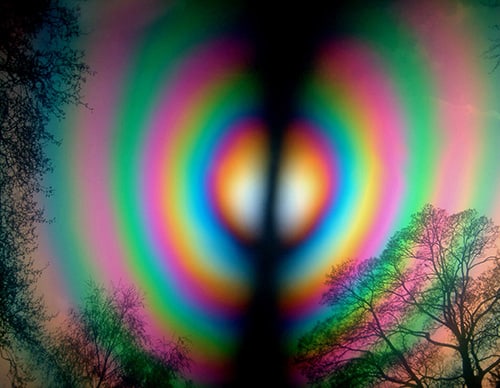
By Kate Gardner
“Pictures convey abstract concepts to each other and to ourselves,” explained Michael Berry last night in his talk “Optica Fantastica: Nature’s optics and our understanding of light” here at IOP Publishing in Bristol as part of the city’s Festival of Ideas. Berry, who is the Melville Wills emeritus professor of physics at the University of Bristol, began by declaring that he was going to take the “opposite approach to Einstein”. Whereas Einstein said, “I want to know God’s thoughts, the rest is just detail”, Berry is interested in those details.
Sponsored by the Institute of Physics, which publishes Physics World, the talk was held to celebrate the International Year of Light 2015 and in it Berry ran the audience through the four levels of understanding light: rays, waves, polarization and quantum. He showed beautiful pictures from his own research but also included some artworks related to the phenomena he was explaining and even quoted passages from novels.
To explain some of the effects of light on water, Berry showed the David Hockney painting “Dive in” and read an extract from AS Byatt’s Possession, in which she described “tessellation in the water’s glaze”.
A series of pictures of interference patterns between random waves allowed Berry to explain phases of light, optical vortices, knot theory and the cosmic microwave background.
The image above was taken by creating what Berry called a “black sandwich” – placing a sheet of overhead transparency foil between two polarizing filters and taking a photo through them with an ordinary digital camera. It creates a beautiful effect (one that I fully intend to try myself just as soon as I can find a supply of overhead transparency foil) and Berry assured us that he can give a full hour’s lecture on the mathematical properties that the image elucidates.
I learned some interesting nuggets, such as the controversy over whether Vikings used polarization in crystals to navigate from Norway and Iceland to Canada 1000 years ago. (Berry’s conclusion is that it’s unlikely but he’d still like it to be true.) And that the halo you sometimes see around your own shadow (or if you’re in an aeroplane, the halo you see around the plane’s shadow on a cloud) is called a Brocken spectre and is described in Thomas Pynchon’s Gravity’s Rainbow.
I also learned that while Berry appreciates art, and can name many examples of science having inspired art, he believes it is a one-way street – he does not know of any science inspired by art (despite a few tentative examples given by the audience). What do you think? Are there any solid examples of art inspiring science?



